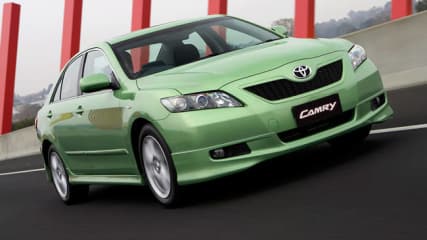Toyota Camry Hybrid Luxury 2010 review
By Neil Dowling · 11 Mar 2010
"Oh, this is the hybrid?," he asks. "Yes." Silence. Because, in truth, that's all he really needs to know.It's a hybrid and it's made in Australia and it's a Toyota and at less than $37,000, it costs the equivalent of a base-model six-cylinder sedan from Ford or Holden and runs on only two-thirds of their fuel consumption. Basically, what's stopping you?Hybrids have been around ever since Mendel split his time between prayer and propagating peas. It's not a bit scary. It drives like any other Camry though its trick of turning off its petrol engine when coasting or at a stop sign is initially freaky. Unlike the high-tech Prius on which the Camry is mechanically and electrically based, nothing is unusual.Appearance It looks like a normal sedan car - true, too much like a normal sedan car - and has a conventional dashboard and switches and dials. The gearshifter looks like a normal automatic shifter, even though it's attached to an unconventional transmission.It seats five adults, the boot is large-ish - but space is crimped a bit by the battery pack - and aside from a tidy up on the outside that greatly improves the Camry donor, it's invisible in the parking lot. You will look at the Camry Hybrid and consider buying it because it is relatively easy on petrol and is practical.There's no doubt it will accept the family in comfort and almost whisper-quiet operation, even with the engine on, and really the only downers are a slightly shorter boot with only a small through-hole for skinny cargo, and the more serious inability to take a tow bar.Fuel economyToyota claims 6 litres/100km which is 32 per cent more economical that the four-cylinder Camry petrol version and any housewife will find 32 per cent a seductive discount, no matter what the product. And it is seductive until you figure that though it will save you about $500 a year in petrol bills (at 15,000km and $1.20 a litre), the Hybrid costs $3000 more than the mid-spec Sportivo with which it shares many features.Be warned: It will take you six years to make up the difference - if you still own the car by then. But it's not about the money, is it? This is a clever piece of engineering and there's a piece of me that quietly puffs out my chest at my ability to allow the Federal Government to give Toyota $35 million to build the car in Australia.As a taxpayer, part of that money, you see, is mine - so I have an attachment. You can also feel tinged with green while pulling away from the lights or reversing out of the underground carpark - the car in motion but no noise from under the bonnet.It's a bit creepy and its silent motion will shock pedestrians habitually operating on their ears to manoeuvre around the city. In fact, the US association for the sight and aural-impaired are quite worried about the potential injury to members as the trend to noiseless vehicles takes hold. Damn environmental concerns!DrivetrainYou will marvel at its ability, seemingly at random, to switch off its polluting engine and run on the electric motor. The motor is charged by the petrol engine and, cleverly, by connecting the onboard generator every time the Camry brakes. It's called regenerative braking.The Camry Hybrid doesn't have a plug-in capability - and thank the heavens for that! Plug-in electric cars have a place but they require more expensive and usually bulkier batteries and have only enough juice for 100km or 150km. The Camry idea, where every thing is onboard, is neater.Toyota's greenest locally-built car comes in two versions - base at $36,990 and Luxury at $39,990. The latter gets leather, sat-nav, sunroof and an upmarket audio and is the affluent way to help the environment eke out a few more centuries.DrivingOn the road it drives like a conventional Camry and once you get used to the engine occasionally napping, only the dull lightness of the electric power steering clarify the difference. Handling feels a bit better because the battery is on the boot and helps balance out the front-wheel drive car.The Hybrid is heavier but it's also more powerful. This translates into a faster time to 100km/h but because of the continuously-variable transmission's wishy-washy lag, it doesn't feel like it's going anywhere for the first few milliseconds. Something weird happened while I was out there behind the wheel - I didn't enjoy punching it. I felt, I don't know, dirty.Here was a car designed to skimp on fuel to save its owner money while helping the planet limp forward on its intergalactic Zimmer frame and I'm trying to drag OPEC into ruin. But, of course, it's quite difficult to make the Camry Hybrid guzzle fuel. Then again, I couldn't match Toyota's 6 litres/100km average, either.I returned 7 l/100km. That's fine. Not anywhere near as good as some Europeans - Volkswagen's petrol 118TSI Golf and diesel TDI models, for example - but better than equivalent petrol-fuelled sedans. A mate got closer, finding an average at about 6.5 l/100km. The difference wasn't anything with our right feet. Rather, I used the freeway and he used a coastal road. I was locked in to 100km/h with the engine never pausing and he was against a string of traffic lights and lots of undulations where the engine could be switched off and electric power used.It's sufficient to make you consider where you live and how you get to work. And if someone asks, tell them with a smug smile that yes, it's a hybrid.
.jpg)








